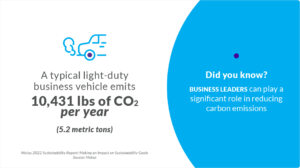
By Ken Robinson, Market Research Manager at Motus
February 20, 2022
Companies have plenty of incentive to reduce carbon emissions and boost sustainability initiatives. Beyond embracing the evolving trend toward energy-efficient technologies and supporting the White House’s goal of halving the economy’s overall greenhouse gas emissions by 2030, sustainability has proven to be a significant indicator of a company’s financial performance and business success. It’s as essential to today’s business climate as it is beneficial to the environment.
Organizations looking to improve their competitive advantages through more efficient use of resources can begin with their fleet vehicles. Transportation currently produces 29% of all greenhouses gasses in the United States, which is more than any other sector. Reducing vehicle emissions can have the greatest impact on sustainability initiatives, since business and personal driving account for 57% of transportation sector emissions. With this in mind, let’s explore how companies can meet their sustainability goals while continuing field operations and preserving driver count.
Measure Your Emissions Footprint
 The journey to a zero-emissions world begins with an assessment of a company’s current state. For an organization to understand the impact of its sustainability efforts, it must establish a baseline measurement of its emissions footprint. Tracking results through ongoing measurements will not only quantify success of existing initiatives, but it will inform next steps to ensure a company’s actions are making the desired impact. Once a business begins measuring its vehicle emissions, it can evaluate and identify which options allow them to make a large-scale positive change.
The journey to a zero-emissions world begins with an assessment of a company’s current state. For an organization to understand the impact of its sustainability efforts, it must establish a baseline measurement of its emissions footprint. Tracking results through ongoing measurements will not only quantify success of existing initiatives, but it will inform next steps to ensure a company’s actions are making the desired impact. Once a business begins measuring its vehicle emissions, it can evaluate and identify which options allow them to make a large-scale positive change.
Analyze Business Driving Habits
Moving the impact of business travel toward a goal of zero emissions will take time and planning, but companies can take immediate steps to reduce the amount of greenhouse gasses they produce. Companies can first analyze the driving habits of their fleets, finding opportunities to optimize trips along specific routes or within certain territories, eliminate unnecessary trips and promote efficient driving behaviors such gradual, rather than fast, acceleration. This will not only reduce carbon emissions, but improve the overall efficiency of each driver within the fleet as well. More efficient management of vehicle fleets produces tangible savings for businesses, especially those with “anywhere” workforces that are becoming increasingly common.
Transition to Hybrid or All-Electric Vehicles
Beyond adjusting driving habits and coaching best practices, companies can also explore their options for hybrid and electric vehicles. Electric vehicles might not yet be feasible for every company, since the models available are still limited and support — ranging from tax credits to the availability of charging stations — varies from state to state. Where they are most viable, electric vehicles offer both environmental and economic benefits. Traveling 100 miles in an electric vehicle can be 75% less expensive than the same trip in a similar gas-powered vehicle, while eliminating the 19.2 pounds of CO2 created with each gallon of fuel burned in a traditional engine (which equates to 5.2 metric tons per year for a typical light-duty business vehicle). Electric vehicles also have greater range per charge than many people might think, easily exceeding the range of a typical day’s business use or round-trip commute. Hybrid vehicles also offer advantages, with hybrid delivery trucks, for example, using an average of 30% less fuel than fully gas-powered trucks and lowering emissions by the same amount.
Reducing emissions of greenhouse gasses, promoting clean energy use and creating a sustainable energy model is everyone’s responsibility. The private sector is uniquely positioned to play a big part in whether those efforts succeed, especially when it comes to vehicle emissions. Businesses leaders that assess the status of their vehicle fleets now can accelerate the move toward zero emissions and produce clean benefits, both environmentally and financially.




